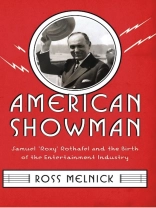Samuel ‘Roxy’ Rothafel (1882–1936) built an influential and prolific career as film exhibitor, stage producer, radio broadcaster, musical arranger, theater manager, war propagandist, and international celebrity. He helped engineer the integration of film, music, and live performance in silent film exhibition; scored early Fox Movietone films such as Sunrise (1927); pioneered the convergence of film, broadcasting, and music publishing and recording in the 1920s; and helped movies and moviegoing become the dominant form of mass entertainment between the world wars.
The first book devoted to Rothafel’s multifaceted career, American Showman examines his role as the key purveyor of a new film exhibition aesthetic that appropriated legitimate theater, opera, ballet, and classical music to attract multi-class audiences. Roxy scored motion pictures, produced enormous stage shows, managed many of New York’s most important movie houses, directed and/or edited propaganda films for the American war effort, produced short and feature-length films, exhibited foreign, documentary, independent, and avant-garde motion pictures, and expanded the conception of mainstream, commercial cinema. He was also one of the chief creators of the radio variety program, pioneering radio broadcasting, promotions, and tours.
The producers and promoters of distinct themes and styles, showmen like Roxy profoundly remade the moviegoing experience, turning the deluxe motion picture theater into a venue for exhibiting and producing live and recorded entertainment. Roxy’s interest in media convergence also reflects a larger moment in which the entertainment industry began to create brands and franchises, exploit them through content release ‘events, ‘ and give rise to feature films, soundtracks, broadcasts, live performances, and related consumer products. Regularly cited as one of the twelve most important figures in the film and radio industries, Roxy was instrumental to the development of film exhibition and commercial broadcasting, musical accompaniment, and a new, convergent entertainment industry.
Daftar Isi
List of Illustrations
Acknowledgments
Introduction
Part 1. Roxy and Silent Film Exhibition
1. A New Art for a New Art Form (1908–1913)
2. Broadway Melody (1913–1917)
3. The Movie House as Recruiting Center (1917–1918)
4. ‘The Man Who Gave the Movies a College Education’ (1919–1922)
Part 2. Roxy and the Emergence of Convergence
5. A Capitol Idea (1922–1925)
6. ‘It’s the Roxy and I’m Roxy’ (1925–1927)
7. It’s All Playing in Sheboygan (1928–1931)
8. The Prologue Is Past (1931–1936)
Afterword
Notes
Bibliography
Index
Tentang Penulis
Ross Melnick is assistant professor of film and media studies at the University of California, Santa Barbara. He received his Ph.D. in cinema and media studies from the University of California, Los Angeles, and a postdoctoral fellowship from Emory University. He has worked as a curator at the Museum of the Moving Image and in marketing for Loews Cineplex, Miramax, Metro-Goldwyn-Mayer, and Dream Works, and in film distribution for Sony Pictures. With Andreas Fuchs, he is the coauthor of
Cinema Treasures.












